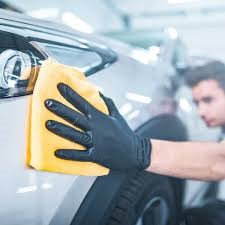 There is a lot confusion, with customers, understanding the difference between color match vs blending paint of cars at body shops. At first glance, you would think that one replaces the other, but that isn’t correct. Why you need both is complex and lengthy, but I’ll do my best to explain.
There is a lot confusion, with customers, understanding the difference between color match vs blending paint of cars at body shops. At first glance, you would think that one replaces the other, but that isn’t correct. Why you need both is complex and lengthy, but I’ll do my best to explain.
Manufacturers Process
Let’s start by understanding what happens at the car manufacturer. When a manufacturer specs paint, for a new car, they put it out to bid to all of the paint manufacturers. It’s important to understand that they do not always use just one paint supplier. New batches could go out for bid again with an entirely new supplier. Every time they make a new batch, there is a variable added into the color. Also, each supplier starts with a different set of base toners and that adds more variables and differences into the process.
Paint Manufacturers Process
Once the factory decides on a new color, samples are sent to each paint manufacturer to match the sample. The paint manufacturer has to take this color sample and get the color to match as best they can with an entirely different material and process of application than is used at the factory. Again, this builds in variables and differences.
Dealing with Factory Variances
Once the car makes its way into the new owner’s hands, it becomes time to start repairing some of these cars. Each paint manufacturer has matched the original spec’d color sample with their paint. But now, they start seeing there are different variances of that original color that are due to manufacturing variables. The reasons are, as I’ve explained, there are different batches, different manufacturers, different processes and different environment. Because of all that, the paint manufacturer has to get a sample of each of these variances and match them. But again, this isn’t a perfect science because every auto body shop has different air pressure, different temperature and different.
Color Matching Camera
To help with the variances in the body shop, the paint manufacturers have developed very sophisticated color matching cameras called a spectrophotometer. These store tens of thousands of color variances. These are sometimes are the best way to obtain the color necessary to match the car, but again, they aren’t close enough.
At this point, I’m sure you can see that there are a lot of variables and all paint isn’t the same. To deal with the variables and make your paint undetectable to the eye, the body shop blends the color.
Blending Paint for a Perfect Match
Blending is the process of tapering the paint out into the adjacent panel in a way that gradually loses the difference to your eye. A well done blend will make it impossible for you to see the repair work.
It is important to note that, on blend panels, if there are chips or dents, they will still be there. If these chips are repaired, you may make it necessary to spray into the next panel. It’s important to understand this and talk to your local shop about what to expect with any preexisting flaws on the blend panels.
At Collision Pros we work hard to make sure all of our repair work is as close as possible to the original look and finish. We don’t do color match vs blending paint, we always do what’d best for the car and the customer. If you have any further questions reach out to any of our location in Auburn, Chico, Paradise, Red Bluff, Loomis or Woodland. Our staff is always here to help. At Collision Pros we get it right, on time, every time.

[…] the original finish. In most cases, to match the factory color, the adjacent panels will have to be blended.If you’ve had an accident and you are trying to decide which is the right dent repair for you, go […]